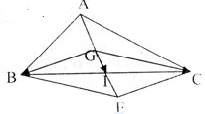Hãy nhập câu hỏi của bạn vào đây, nếu là tài khoản VIP, bạn sẽ được ưu tiên trả lời.

Mệnh đề C sai
\(\overrightarrow{GA}+\overrightarrow{GB}=-\overrightarrow{GC}\)
Mà hai vecto \(\overrightarrow{GC}\) và \(\overrightarrow{AM}\) ko cùng phương nên đẳng thức \(\overrightarrow{GA}+\overrightarrow{GB}=\frac{3}{2}\overrightarrow{AM}\) ko thể xảy ra

a: \(\overrightarrow{AB}+\overrightarrow{DC}=\overrightarrow{AI}+\overrightarrow{IB}+\overrightarrow{DI}+\overrightarrow{IC}\)
\(=\overrightarrow{AI}+\overrightarrow{DI}=-\left(\overrightarrow{IA}+\overrightarrow{ID}\right)=-2\overrightarrow{IM}=2\overrightarrow{MI}\)
\(\overrightarrow{AB}+\overrightarrow{DC}=\overrightarrow{AC}+\overrightarrow{DB}\)
\(\Leftrightarrow\overrightarrow{AB}-\overrightarrow{AC}=\overrightarrow{DB}-\overrightarrow{DC}\)
\(\Leftrightarrow\overrightarrow{CA}+\overrightarrow{AB}=\overrightarrow{CD}+\overrightarrow{DB}=\overrightarrow{CB}\)(luôn đúng)
=>ĐPCM
b: \(\overrightarrow{GA}+\overrightarrow{GB}+\overrightarrow{GC}+\overrightarrow{GD}\)
\(=2\cdot\overrightarrow{GM}+2\cdot\overrightarrow{GI}=\overrightarrow{0}\)

Bài 2:
Gọi M là trung điểm của AB,N là trung điểm của CD
vecto GA+vecto GB+vecto GC+vecto GD=vecto 0
=>2 vetco GM+2 vecto GN=vecto 0
=>vecto GM+vecto GN=vecto 0
=>G là trung điểm của MN

Câu 1:
\(AC=\sqrt{AB^2+BC^2}=\sqrt{2}\)
\(\Rightarrow\overrightarrow{AB}.\overrightarrow{AC}=AB.AC.cos45^0=1.\sqrt{2}.\frac{\sqrt{2}}{2}=1\)
Đáp án D sai
Câu 2:
\(BN=\frac{1}{2}BM=\frac{1}{4}BC\Rightarrow4\overrightarrow{BN}=\overrightarrow{BC}\)
Ta có:
\(4\overrightarrow{AN}=4\left(\overrightarrow{AB}+\overrightarrow{BN}\right)=4\overrightarrow{AB}+4\overrightarrow{BN}=4\overrightarrow{AB}+\overrightarrow{BC}\)
\(=4\overrightarrow{AB}+\overrightarrow{BA}+\overrightarrow{AC}=4\overrightarrow{AB}-\overrightarrow{AB}+\overrightarrow{AC}=3\overrightarrow{AB}+\overrightarrow{AC}\)
Đáp án A đúng

G A B C M
A. Ta có G là trọng tâm của tam giác ABC
\(\Rightarrow\overrightarrow{AG}=2\overrightarrow{GM}\)
Hay: \(\overrightarrow{GA}=-2\overrightarrow{GM}\)
\(\Rightarrow\overrightarrow{GA}+2\overrightarrow{GM}=\overrightarrow{0}\) ( Đúng)
B. Ta có:
\(\overrightarrow{OA}+\overrightarrow{OB}+\overrightarrow{OC}=\overrightarrow{OG}+\overrightarrow{GA}+\overrightarrow{OG}+\overrightarrow{GB}+\overrightarrow{OG}+\overrightarrow{GC}\)
\(=\left(\overrightarrow{GA}+\overrightarrow{GB}+\overrightarrow{GC}\right)+3\overrightarrow{OG}=\overrightarrow{0}+3\overrightarrow{OG}=\overrightarrow{3OG}\) ( Đúng)
C. \(\overrightarrow{GA}+\overrightarrow{GB}+\overrightarrow{GC}=\overrightarrow{0}\) ( Đúng, đây là điều hiển nhiên)
D. Ta có G là trọng tâm của tam giác ABC
\(\Rightarrow\overrightarrow{AM}=3\overrightarrow{GM}\)
\(\Rightarrow\overrightarrow{AM}=-3\overrightarrow{GM}\)
Vậy đáp án D sai

Câu 1:
Theo tính chất trọng tâm và đường trung tuyến, ta thấy \(\overrightarrow {AM}; \overrightarrow{GM}\) là 2 vecto cùng phương, cùng hướng và \(AM=3GM\)
\(\Rightarrow \overrightarrow{AM}=3\overrightarrow{GM}\)
\(=\frac{3}{2}(\overrightarrow{GM}+\overrightarrow{GM})\) \(=\frac{3}{2}(\overrightarrow{GB}+\overrightarrow{BM}+\overrightarrow{GC}+\overrightarrow{CM})\)
\(=\frac{3}{2}[(\overrightarrow{GB}+\overrightarrow{GC})+(\overrightarrow{BM}+\overrightarrow{CM})]\)
\(=\frac{3}{2}(\overrightarrow{GB}+\overrightarrow{GC})\) (vecto \(\overrightarrow{BM}; \overrightarrow{CM}\) là 2 vecto đối nhau nên tổng bằng vecto $0$)
Đáp án B
Câu 2:
\(\overrightarrow{u}=\overrightarrow{AB}+\overrightarrow{DC}+\overrightarrow{BD}+\overrightarrow{CA}\)
\(=(\overrightarrow{AB}+\overrightarrow{BD})+(\overrightarrow{DC}+\overrightarrow{CA})=\overrightarrow{AD}+\overrightarrow{DA}\)
\(=\overrightarrow{0}\) (tổng của 2 vecto đối nhau)
Đáp án C
Câu 3:
Bạn nhớ rằng \(\overrightarrow{a}; k\overrightarrow{a}(k\in\mathbb{R})\) luôn là 2 vecto cùng phương (tính chất vecto). Nhưng nó mới chỉ là cùng phương thôi. Muốn cùng phương +cùng hướng thì \(k>0\) ; muốn cùng phương + ngược hướng thì \(k< 0\). Nói chung là phụ thuộc vào tính chất của $k$
Câu C thì hiển nhiên sai.
Nên đáp án B đúng

\(\overrightarrow{BI}=\overrightarrow{BC}+\overrightarrow{CI}=\overrightarrow{BC}-\frac{1}{2}\overrightarrow{AB}\)
\(\overrightarrow{BG}=\frac{1}{3}\left(\overrightarrow{BI}+\overrightarrow{BC}\right)=\frac{1}{3}\left(\overrightarrow{BC}-\frac{1}{2}\overrightarrow{AB}+\overrightarrow{BC}\right)=\frac{2}{3}\overrightarrow{BC}-\frac{1}{6}\overrightarrow{AB}\)
\(\overrightarrow{AG}=\overrightarrow{AB}+\overrightarrow{BG}=\overrightarrow{AB}+\frac{2}{3}\overrightarrow{BC}-\frac{1}{6}\overrightarrow{AB}=\frac{5}{6}\overrightarrow{AB}+\frac{2}{3}\overrightarrow{BC}=\frac{5}{6}\overrightarrow{a}+\frac{2}{3}\overrightarrow{b}\)

c) \(\overrightarrow{BG}+\overrightarrow{GC}=\overrightarrow{BC}\ne\overrightarrow{GA}\)
d) \(\overrightarrow{GB}+\overrightarrow{GC}=\dfrac{1}{2}\overrightarrow{GM}\ne\overrightarrow{GM}\)